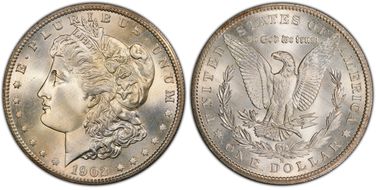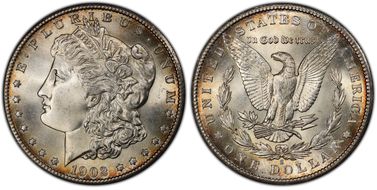- PCGS #:
- 7282
- Designer:
- George T. Morgan
- Edge:
- Reeded
- Diameter:
- 38.10 millimeters
- Weight:
- 26.73 grams
- Mintage:
- 1,530,000
- Mint:
- San Francisco
- Metal:
- 90% Silver, 10% Copper
- Auction Record:
- $99,875 • MS67+ • 10-15-2015 • Legend Rare Coin Auctions
Die Varieties
- 1902-S $1 VAM 1
- 1902-S $1 VAM 1, PL
- 1902-S $1 VAM 1, DMPL
- 1902-S $1 VAM 2
- 1902-S $1 VAM 2, PL
- 1902-S $1 VAM 2, DMPL
- 1902-S $1 VAM 3
- 1902-S $1 VAM 3, PL
- 1902-S $1 VAM 3, DMPL
- 1902-S $1 VAM 4
- 1902-S $1 VAM 4, PL
- 1902-S $1 VAM 4, DMPL
- 1902-S $1 VAM 5
- 1902-S $1 VAM 5, PL
- 1902-S $1 VAM 5, DMPL
- 1902-S $1 VAM 6
- 1902-S $1 VAM 6, PL
- 1902-S $1 VAM 6, DMPL
- 1902-S $1 VAM 7
- 1902-S $1 VAM 7, PL
- 1902-S $1 VAM 7, DMPL
- 1902-S $1 VAM 8
- 1902-S $1 VAM 8, PL
- 1902-S $1 VAM 8, DMPL
Go To Grade
Current Auctions - PCGS Graded
Current Auctions - NGC Graded
For Sale Now at Collectors Corner - PCGS Graded
For Sale Now at Collectors Corner - NGC Graded
Rarity and Survival Estimates Learn More
| Survival Estimate | |
|---|---|
| All Grades | 153,000 |
| 60 or Better | 35,000 |
| 65 or Better | 1,168 |
| Numismatic Rarity | |
|---|---|
| All Grades | R-1.9 |
| 60 or Better | R-2.6 |
| 65 or Better | R-4.9 |
| Relative Rarity By Type All Specs in this Type | |
|---|---|
| All Grades | 33 / 117 TIE |
| 60 or Better | 42 / 117 TIE |
| 65 or Better | 45 / 117 TIE |
| Relative Rarity By Series All Specs in this Series | |
|---|---|
| All Grades | 33 / 117 TIE |
| 60 or Better | 42 / 117 TIE |
| 65 or Better | 45 / 117 TIE |
Condition Census What Is This?
Q. David Bowers:
The following narrative, with minor editing, is from my "Silver Dollars & Trade Dollars of the United States: A Complete Encyclopedia" (Wolfeboro, NH: Bowers and Merena Galleries, Inc., 1993).
Numismatic Information
Hoard coins: Large quantities of 1902-S dollars were paid out from storage at the San Francisco Mint over a long period of years, with substantial releases occurring in the late 1920s, 1940s, and early 1950s, plus at other intervals. The Redfield estate (1976) is said to have had up to a bag of 1902-S dollars, most being either of MS-60 to MS-63 grade (per John Highfill) or of high quality (per Wayne Miller). Numismatically, 1902-S was never considered to be a rare date, even in the early years. However, today it is considered to be of medium scarcity.
Circulated grades: In worn grades the 1902-S is one of the more elusive issues in the Morgan series.
Mint State grades: Thousands of coins exist.
Most are in the lower ranges of MS-60 to 63, although 64s are not rare. MS-65 coins, if sharply struck, are surprisingly elusive, more so than realized as recently as the mid-1980s (before the launching of PCGS and NGC). In relatively recent years, 20-coin rolls have been a common sight at conventions. These usually contain coins in the MS-62 to 63 range, with some lower, but few higher. Now that the certification services have become so widely accepted, roll offerings of scarce Morgan dollars are fewer; many owners simply send such quantities to the services and let the chips fall where they may, hoping to get a few high-grade pieces out of the lot.
I estimate that 25,000 to 40,000 MS-60 to 62 coins exist, placing the 1902-S in the "scarce" class. MS-63 coins exist to the extent of 9,000 to 16,000 pieces, and only 4,000 to 8,000 MS-64 examples survive. Just 700 to 1,400 MS-65 pieces are known.
The typical 1902-S Morgan dollar is somewhat lightly struck. Lustre is satiny, sometimes "greasy," rarely deeply frosty. Some pieces show parallel striae on the planchet, a vestige of the drawing bench operation prior to coinage.
Prooflike coins: Prooflike examples are rare and are often on striated planchets. DMPL pieces are extremely rare and are likewise usually on defective planchets. As such pieces have low aesthetic appeal, demand is small.
Varieties
NEW OVER OLD HUB: DOUBLE OLIVE AT CLAW
VAM C-4 OVER C-3 REVERSE
Circulation strikes:
1. C-4 reverse hub over C-3: Breen-5694, VAM 3-8. Another instance of this over-hub, unknown a few decades ago, being plentiful today.
NEW REVERSE HUB: WIDE NECK/WING SPACE, LARGE STARS
VAMC-4
Circulation strikes:
1. Breen-5693, VAM-I, 2. Uncirculateds are usually weak and often on striated blanks. The "filled 2" coins (VAM-I, late) have die chipped between upper base and middle curve of 2.
Probably not all the 20 obverse dies and seven reverses prepared for 1902-8 dollars were used. As always, any unused reverses were probably saved for the next year.
Dies prepared: Obverse: 20; Reverse: 7.
Circulation strike mintage: 1,530,000; Delivery figures by month: January: none; February: none; March: none; April: none; May: none; June: none; July: none; August: none; September: 500,000; October: 510,000; November: 520,000; December: none.
Estimated quantity melted: Not known, but probably at least half of the mintage (approximately 750,000 coins) was destroyed under the 1918 Pittman Act.
Availability of prooflike coins: Very rare, but not desirable as most are on striated planchets.
Characteristics of striking: Varies from weak to sharp. Many Mint State pieces show heavy striations.
Known hoards of Mint State coins: Bags were released by the Treasury in the 1950s and in 1962-1964.
Commentary
The 1902-S is about as scarce in worn grades as in Mint State.
Distribution of Dollars
The Annual Report of the Director of the Mint, 1902, told of the distribution of silver dollars: San Francisco: In mint June 30, 1901, 55,977,333; transferred from Treasury for storage, 150,000; coinage, fiscal year 1902, 436,000; total, 56,563,333; in mint June 30, 1902, 55,804,122; distributed from mint, 759,211.
Numismatic Information
Hoard coins: Large quantities of 1902-S dollars were paid out from storage at the San Francisco Mint over a long period of years, with substantial releases occurring in the late 1920s, 1940s, and early 1950s, plus at other intervals. The Redfield estate (1976) is said to have had up to a bag of 1902-S dollars, most being either of MS-60 to MS-63 grade (per John Highfill) or of high quality (per Wayne Miller). Numismatically, 1902-S was never considered to be a rare date, even in the early years. However, today it is considered to be of medium scarcity.
Circulated grades: In worn grades the 1902-S is one of the more elusive issues in the Morgan series.
Mint State grades: Thousands of coins exist.
Most are in the lower ranges of MS-60 to 63, although 64s are not rare. MS-65 coins, if sharply struck, are surprisingly elusive, more so than realized as recently as the mid-1980s (before the launching of PCGS and NGC). In relatively recent years, 20-coin rolls have been a common sight at conventions. These usually contain coins in the MS-62 to 63 range, with some lower, but few higher. Now that the certification services have become so widely accepted, roll offerings of scarce Morgan dollars are fewer; many owners simply send such quantities to the services and let the chips fall where they may, hoping to get a few high-grade pieces out of the lot.
I estimate that 25,000 to 40,000 MS-60 to 62 coins exist, placing the 1902-S in the "scarce" class. MS-63 coins exist to the extent of 9,000 to 16,000 pieces, and only 4,000 to 8,000 MS-64 examples survive. Just 700 to 1,400 MS-65 pieces are known.
The typical 1902-S Morgan dollar is somewhat lightly struck. Lustre is satiny, sometimes "greasy," rarely deeply frosty. Some pieces show parallel striae on the planchet, a vestige of the drawing bench operation prior to coinage.
Prooflike coins: Prooflike examples are rare and are often on striated planchets. DMPL pieces are extremely rare and are likewise usually on defective planchets. As such pieces have low aesthetic appeal, demand is small.
Varieties
NEW OVER OLD HUB: DOUBLE OLIVE AT CLAW
VAM C-4 OVER C-3 REVERSE
Circulation strikes:
1. C-4 reverse hub over C-3: Breen-5694, VAM 3-8. Another instance of this over-hub, unknown a few decades ago, being plentiful today.
NEW REVERSE HUB: WIDE NECK/WING SPACE, LARGE STARS
VAMC-4
Circulation strikes:
1. Breen-5693, VAM-I, 2. Uncirculateds are usually weak and often on striated blanks. The "filled 2" coins (VAM-I, late) have die chipped between upper base and middle curve of 2.
Probably not all the 20 obverse dies and seven reverses prepared for 1902-8 dollars were used. As always, any unused reverses were probably saved for the next year.
Dies prepared: Obverse: 20; Reverse: 7.
Circulation strike mintage: 1,530,000; Delivery figures by month: January: none; February: none; March: none; April: none; May: none; June: none; July: none; August: none; September: 500,000; October: 510,000; November: 520,000; December: none.
Estimated quantity melted: Not known, but probably at least half of the mintage (approximately 750,000 coins) was destroyed under the 1918 Pittman Act.
Availability of prooflike coins: Very rare, but not desirable as most are on striated planchets.
Characteristics of striking: Varies from weak to sharp. Many Mint State pieces show heavy striations.
Known hoards of Mint State coins: Bags were released by the Treasury in the 1950s and in 1962-1964.
Commentary
The 1902-S is about as scarce in worn grades as in Mint State.
Distribution of Dollars
The Annual Report of the Director of the Mint, 1902, told of the distribution of silver dollars: San Francisco: In mint June 30, 1901, 55,977,333; transferred from Treasury for storage, 150,000; coinage, fiscal year 1902, 436,000; total, 56,563,333; in mint June 30, 1902, 55,804,122; distributed from mint, 759,211.






